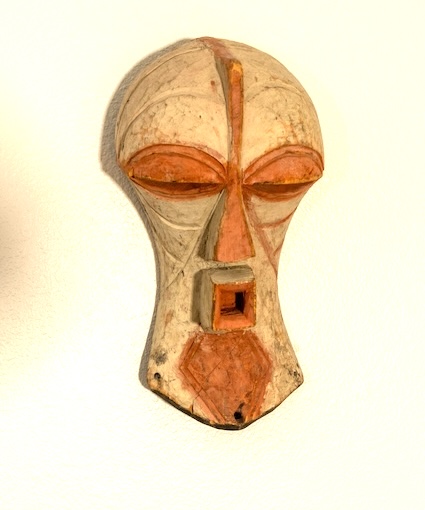Kifwebe Masks

Kifwebe is a word meaning “mask” for the people of the Congo River basin, the Luba and Songye tribes. High-ranking, ruling elite men in a tribal secret brotherhood called Bwadi Bwa Kifwebe would wear these masks in a ritual dance, complete with a disguise of a woven, tight-fitting net-like costume, animal pelts, and long, thick, dark raffia beards. The ritual was danced to ward off unseen enemies; to accompany a soul during a funeral; as a celebration in initiation; to conquer evil spirits and illness; and to protect from disaster. Some scholars believe the kifwebe were used in a human sacrifice ritual.
The masks were sacred to the Bwadi Bwa Kifwebe brotherhood and played a role in the establishment of order and retention of elite power in the community. Varying in size from a whole helmet to a small maskette or pendant, the mask wearers would appear at secular and sacred events, such as healing rituals and new moon rites.
The kifwebe masks of the Congo River basin are distinctive and stylized representations of a human skull, and are painted in combinations of white, red, and black. Red was associated with aggression and blood, white with purity. White was used on female masks; the noses, eyes, and mouths did not protrude as much as the male masks’ features. The white is a pigment made from kaolin powder. The masks were carved with deep grooves or striations, which retained the pigment and thus emphasized the grooves, as seen in LL’s mask around the eyes. In a ritual dance setting, the lines on the masks would catch the firelight or the sunlight, providing the masks’ face an illusion of being rippling and alive. Some scholars believe that the tradition of the striated grooves on the kifwebe masks indicate a connection between the mystical powers held by both the porcupine and the zebra, striped creatures of high contrast, representing good and evil, black and white.
LL’s mask is a male mask, as we can see from the forehead line down to the prominent nose, a feature on all male masks. The exaggeration of the nose and the mouth indicate that the skull’s spirit could smell and project speech. The mask was sculpted in three dimensions creating a balanced symmetrical face, featuring that characteristic extended mouth. The masks were attached to a human face by threading cords into the holes around the mask and wrapping the head. The masks covered the entire face and ears while the neck was covered by a huge beard. The costume would have disguised the wearer.
The lines carved on the mask contain magic themselves in that they represent certain numbers and elements of magic associated with those numbers. This knowledge was known to the Bwadi Bwa Kifwebe brotherhood and passed down. The esoteric knowledge was associated with the ideology of magic, sorcery, and witchcraft used for good and ill, with the central focus on control and power. The Bwadi Bwa Kifwebe members, acting as community policemen, would don the masks and dance away disruptive elements, reestablishing order and their own rulership of the group. LL’s mask is the very essence of its former owner’s belief in mystical power, and represents an attempt to control the uncontrollable and to know the unknowable. That attempt seems to lie at the heart of humankind’s search for a spirit power larger than the human being.
These masks became associated with the quest – in the first quarter of the 20th century – for a new language in modern art; so their creative spirit lived on. The kifwebe masks were widely collected through French-speaking Belgian dealers who traded in Congo. The best and most knowledgeable of all early African art dealers were based in Paris, and still are to this day.
Each feature and color and carving on the mask represents a spirit force, whether that spirit be human or animal. The shape of the face on the mask indicates the type of spirit and the method of control the mask might exude. For example, a round-faced mask with round concentric grooves would have been used for benevolent purposes. LL’s mask was likely used for more aggressive purposes, such as to purify the community of evil sorcerers.
Today in the Democratic Republic of the Congo the Kifwebe masked dance rituals are used to pass down cultural traditions, as well as for performance and entertainment. In the 19th century, however, the masks were as serious as demonic possession. Tradition, history, power, and beauty are represented in these kifwebe masks; LL’s is worth $1,500.







You must be logged in to post a comment.